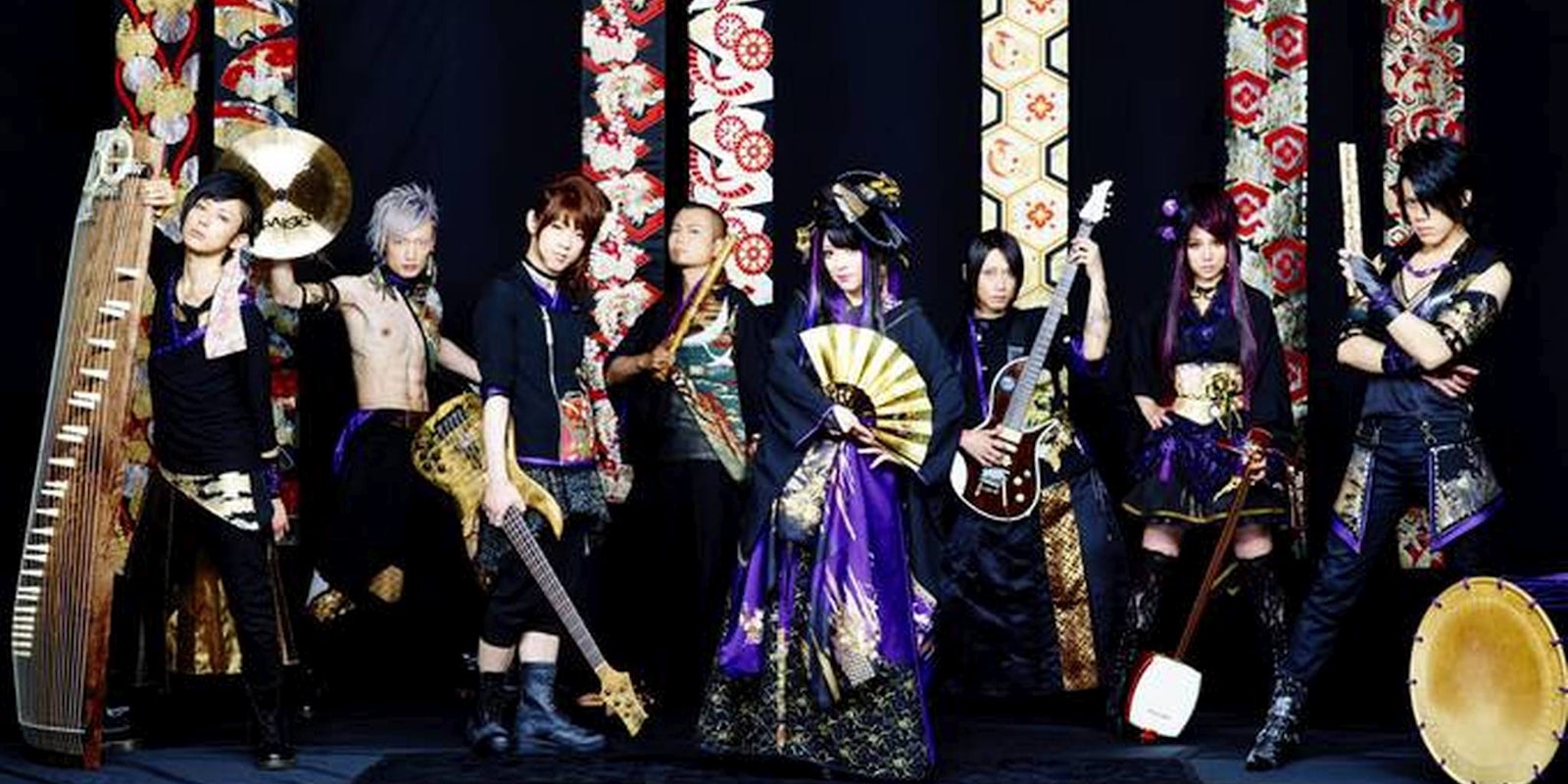Japan’s Waggaki Band is playing for about 100 people in a Texas parking lot. It’s late March at the band’s third-ever American gig at the South by Southwest music conference. This is apparently what 60 million YouTube plays translate to in real life.
The eight-piece outfit is appearing on the Smartpunk Showcase with turn-of-the-century alt-rock avengers like Unwritten Law and Fenix TX. It’s a curious fit for a band composed of musicians trained on traditional Japanese instruments, like that distinct yet indescribable wooden flute you always hear in movies.
This bamboo woodwind is called the shakuhachi, by the way—and it’s being masterfully presented by Daisuke Kaminaga. His head shaven, dark kimono shimmering, Kaminaga is a craftsman of onstage elegance and efficiency. Colleague Kiyoshi Ibukuro is plucking the koto, a 16th century harp. Beni Ninagawa is stage left, on the tsugaru shamisen—essentially a three-stringed banjo. Standing behind this line of classicists, band member Kurona bangs on a set of wadaiko, Japanese drums.
But for the elegant attire and brandishing of historical sonic weaponry, the collective crunches and rips in the wake of outfitted, theatrical American bands like Slipknot and regional contemporaries like BabyMetal. Earlier, they told another reporter that they were really into deceased bluesman Stevie Ray Vaughan. Dense jams like “Ikusa” boast soaring guitar solos that pop with a speedy, nu metal heart.
Singer Y?ko Suzuhana is the key. She sings with power and grace, waving a shimmering hand fan and donning red robes as she performs. At 5 years old, Suzuhana was roped into shigin, a craft of poetry believed to have originated in ancient China that is sung when performed. To Western audiences, these vocals are mystic, angelic, and ultimately familiar—probably why Suzuhana got bored and added speed metal into the mix.
She also studied dance, which explains the fluid, post-David Lee Roth rock star posturing.
“If it’s a more muscular, samurai kind of poem, the sword is used; if it’s more intimate, I’m using the folding fans,” Suzuhana tells the Daily Dot prior to the performance.
She decides to take it easy on us and stick to the folding fans.
Before their Texas debut, the Internet-famous J-pop band is making the press rounds onsite. They’re huddled around a backstage couch while translator Kaz Hayashida fields questions.
I ask how Suzuhana convinced a bunch of her misfit, metal-loving friends to walk off a proverbial plank and become an art project. When Mumford & Sons took cues from the O Brother Where Art Thou soundtrack and dressed like 1930s rural American southerners, revivalist folk music was commercially viable. Shakuhachi solos? Not so much.
“All of the band members like something fun and new. When I said ‘let’s do it,’ it just kind of came together,” Suzuhana says. “I knew from the beginning, when I was starting with the concept, that this would work. I believed it. Once I made it and uploaded it on social media and views skyrocketed—that moment—I knew it was working.”
The band’s real breakout moment was the 2014 single “Senbonzakura,” its video adorned with almost 40 million YouTube streams. Last year’s “Hangeki no Yaiba” would become the theme song to the Attack On Titan animated spinoff series.
Beyond the splashy videos, the band members say the tunes work because of a “fusion between old and new, between West and East” that defines not only their sound, but the anachronisms of modern Japan. As the Daily Beast reported, “Wagakki” literally means “ancient instruments” and these throwback stylings were enough to land a No. 1 album in their home country.
“Our style is modern Japan,” caped, shirtless drummer Wasabi says with assured curtness.
What does that mean, exactly? Bass player Asa gets sarcastic: “There is no ninja.”
For now, the band is stuck between home court dominance, viral success, and the task of conquering foreign lands. Their main weapon is YouTube, a cherished medium because they can “reach international fans by receiving a comment from all over the world.”
I ask about the perils of stardom. Is there anxiety? What’s frustrating about this awkward stage between Web hits and—here in Austin—alien gawks from strangers? Kurona has a logical, if unintentionally mechanical answer: “The downside is that we are discovered via the keyword, so it’s very keyword-sensitive and [we receive] a narrow audience compared to the mainstream.”
The game plan for the rest of 2016, though, is equally measured and procedural. More “visual pieces” (music videos) are on the way and they hope to be back for an American tour soon.
They say that gig days begin at 6am. That, by 8am they are in full Waggaki Band regalia and are just starting rehearsals at 1pm. I’m fairly confident the dudes were joshing me about the way-early, comically disciplined early mornings, though.
Sometimes it’s admittedly awkward when, say, Wasabi walks into a coffeeshop shirtless in his cape. The costumes are part of the job, and they seem intent on staying in full presentation mode whenever possible. They are meticulous professionals—plus he’s used to darting away from such encounters.
“In that awkward moment, I become a ninja.”


